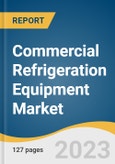The global commercial refrigeration equipment market size is estimated to reach USD 58.31 billion by 2030, registering an estimated CAGR of 5.2% from 2023 to 2030. The major aspects driving the market growth are the increasing consumption of frozen foods and the significant expansion of tourism and hospitality industries.
The rising environmental concerns about harmful emissions produced by refrigerators such as Hydro-chlorofluorocarbons (HCFC) and Chlorofluorocarbons (CFC) have led to the establishment of norms promoting the adoption of energy-efficient equipment for commercial refrigeration. The Clean Air Act launched by the U.S. Environment Protection Agency mandates the regularized application of low Global Warming Potential (GWP) refrigerants in the commercial segment.
Such regulatory measures are urging the companies operating in market to develop energy-efficient offerings with lesser environmental impact. For instance, in September 2022, Carrier Transicold introduced its new range of cutting-edge sustainable and electric temperature-controlled transport units at IAA Transportation 2022 in Germany. The new product offerings include Carrier’s first hydrogen fuel cell-powered Vector trailer unit supporting the temperature-controlled transport solutions for decarbonizing the cold chain.
The global outbreak of the COVID-19 pandemic had severely affected the commercial foodservice industry and retail industries, thereby impacting the expansion of the commercial refrigeration equipment market. However, the industry witnessed a strong demand from the pharmaceutical and biotechnology industries with the increasing need to produce and store vaccines. Several pharmaceutical firms and research institutes demanded vaccine storage refrigerators as a part of their R&D activities to deliver life-saving vaccines against the coronavirus.
The rising environmental concerns about harmful emissions produced by refrigerators such as Hydro-chlorofluorocarbons (HCFC) and Chlorofluorocarbons (CFC) have led to the establishment of norms promoting the adoption of energy-efficient equipment for commercial refrigeration. The Clean Air Act launched by the U.S. Environment Protection Agency mandates the regularized application of low Global Warming Potential (GWP) refrigerants in the commercial segment.
Such regulatory measures are urging the companies operating in market to develop energy-efficient offerings with lesser environmental impact. For instance, in September 2022, Carrier Transicold introduced its new range of cutting-edge sustainable and electric temperature-controlled transport units at IAA Transportation 2022 in Germany. The new product offerings include Carrier’s first hydrogen fuel cell-powered Vector trailer unit supporting the temperature-controlled transport solutions for decarbonizing the cold chain.
The global outbreak of the COVID-19 pandemic had severely affected the commercial foodservice industry and retail industries, thereby impacting the expansion of the commercial refrigeration equipment market. However, the industry witnessed a strong demand from the pharmaceutical and biotechnology industries with the increasing need to produce and store vaccines. Several pharmaceutical firms and research institutes demanded vaccine storage refrigerators as a part of their R&D activities to deliver life-saving vaccines against the coronavirus.
Commercial Refrigeration Equipment Market Report Highlights
- In terms of product, refrigerators and freezers segment held a revenue share of about 25.0% in 2022 owing to the increased demand for vaccine storage units during the pandemic for conducting the immunization process
- In terms of application, food and beverage distribution segment is estimated to record a substantial CAGR from 2023 to 2030 with the ongoing developments in cold channel logistics for transporting temperature-sensitive items
- In terms of system type, the self-contained segment held around 86.0% revenue share in 2022 owing to increasing demand driven by the ease of installation and low maintenance and relocation cost of appliances
- In terms of capacity, the 51 cu. Ft. - 100 cu. Ft. segment held a notable revenue share of more than 45.0% in 2022, owing to the rising number of specialty food stores, hypermarkets, and supermarkets across the globe
- North America captured a sizeable revenue share in 2022 owing to greater consumer inclination toward the adoption of smart equipment across commercial kitchens
Table of Contents
Chapter 1 Methodology and Scope
Chapter 2 Executive Summary
Chapter 3 Market Variables, Trends & Scope
Chapter 4 Product Estimates and Trend Analysis
Chapter 5 Application Estimates and Trend Analysis
Chapter 6 System Type Estimates and Trend Analysis
Chapter 7 Capacity Estimates and Trend Analysis
Chapter 8 Regional Estimates & Trend Analysis
Chapter 9 Competitive Landscape
List of Tables
List of Figures
Companies Mentioned
- AHT Cooling Systems GmbH
- Ali Group S.r.l. a Socio Unico
- Carrier
- Daikin Industries, Ltd.
- Dover Corporation
- Electrolux AB
- Hussmann Corporation
- Illinois Tool Works Inc.
- Johnson Control
- Lennox International Inc.
- Panasonic Corporation
- Whirlpool Corporation
Methodology

LOADING...
Table Information
| Report Attribute | Details |
|---|---|
| No. of Pages | 127 |
| Published | September 2023 |
| Forecast Period | 2022 - 2030 |
| Estimated Market Value ( USD | $ 39.31 Billion |
| Forecasted Market Value ( USD | $ 58.31 Billion |
| Compound Annual Growth Rate | 5.2% |
| Regions Covered | Global |
| No. of Companies Mentioned | 12 |









